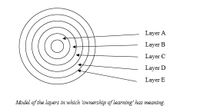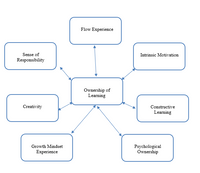Research
How does educational culture relate to ‘student ownership of learning’?
Introduction
The research relates the outcomes of ‘game-based research’ with the experiences of ‘ownership of learning’ of students. It has always been SOL’s quest to find out what educational cultural aspects could stimulate ownership. The tools that we have developed are standardized and our approach over the years has generated a lot of data. We are taking this research into the next level!
The 5 layers
'Ownership of learning' concept has many dimensions. Looking for an appropriate definition of this concept, we repeatedly came up with new perspectives, and eventually developed a layered model that fits the various aspects of the concept. Each perspective has a different description. With the help of this model, we defined the concept in such a way that a complex but more complete definition came into being.
Our model consists of five concentric circles, whereby each circle represents a layer.
Layer D and the taxonomy
Layer D deals with the educational culture within the schools that defines the growth of ownership of learning. To identify these cultures, we use a taxonomy derived from a model used for the degree of 'shared leadership' in schools. The model is derived from a taxonomy designed by John MacBeath who for that purpose did research with eleven different schools. (MacBeath, 2005, De Koning, 2011) This model forms the basis of a taxonomy of schools from the perspective of 'ownership of learning'. The following six types of schools are distinguished: formal, pragmatic, strategic, incremental, competent, and cultural. Below are the six types of schools with a short description:
• The formal school. This is a traditional school. The distribution of roles and tasks in the school is traditional.
• The pragmatic school is a warm -we are family- school. Here you can see an ad hoc allocation of roles, tasks, and responsibilities.
• The strategic school is a modern school, a well-oiled machine. A planned and systematic distribution of roles, tasks and responsibilities takes place here.
• The incremental school is a 'conscious' school: The distribution of roles and tasks aims to enhance student ownership.
• The competent school is the school of recognition: Here ownership is more shared than divided.
• The cultural school is a sustainable school. Shared ownership is deeply anchored in practice and thinking.
The game WOTS
Based on this taxonomy, the SOL foundation developed a board-game that encourages the player to articulate the culture of their school and their idea about what is the most desired culture for the future of their school. The game is played with all participants of the school community, from de students to the board members. The game generates data that can be used to define the direction of the school development.
Layer 1, the experience, 7 indicators, questionnaire
To enhance the experience of ‘ownership of learning’ is ultimately the goal of any intervention aimed at changing the educational culture. We explored current notions of ‘ownership of learning’, examined the existing literature on this topic and then reasoned out as sharply as possible to identify a list of elements that describes aspects of the concept. This should ultimately give us a string of elements that together define the experience in which 'learning belongs to the learner in an intimate way’.
The seven indicators of 'ownership of learning' (layer A)
The seven concepts described above are all characteristics of the experience of 'ownership of learning'. The question as to which concept contributes more or less to ownership cannot be directly answered as the construct is too qualitative. It is a wide and diverse palette of concepts derived from a broad collection of theories. Using this set of indicators, the SOL foundation developed a questionnaire to measure the experiences that students have while learning. The questionnaire has been tested and evaluated in the last two years and is now ready for usage in the field.
The research questions
The research question that the foundation eventually wants to answer is: what is the relationship between the various types of ownership of learning in schools (as perceived by all stakeholders in the school) and the ownership experienced? Looking at the model of the five layers, one could also rephrase the question to: what is the relation between layer D and layer A. SOL has collected a large amount of data on layer D, the school cultures and is about to start collecting data on layer A. Co-relating both data is the great challenge of the SOL foundation research.



